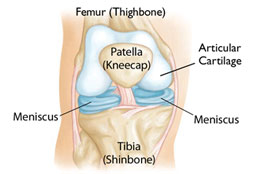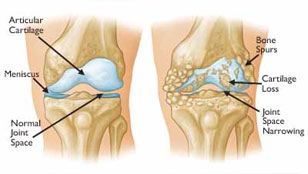What is Osteoarthritis
Osteoarthritis is the most common form of arthritis. Osteoarthritis occurs when the cartilage that lines your joints wears down over time.
Osteoarthritis is a common condition that many people develop during middle age or older. It can occur in any joint in the body, but most often develops in weight-bearing joints, such as the knee and the hip. It is more commonly understood as the age-related wear and tear of the joint.
Osteoarthritis can affect any joint in your body. Most commonly it affects your
- Hips
- Knees
- Hands
- Spine
Knee Osteoarthritis
Arthritis is inflammation of one or more of your joints. Pain, swelling, and stiffness are the primary symptoms of arthritis. Any joint in the body may be affected by the disease, but it is particularly common in the knee.
Knee arthritis can make it hard to do many everyday activities, such as walking, sitting in low chair, squatting or climbing/descending stairs. It is a major cause of lost work time and a serious disability for many people.
Although there is no cure for arthritis, there are many treatment options available to help manage pain and keep people staying active.
Understanding the Knee Joint
The knee is one of the strongest joint in your body. It is made up of the lower end of thighbone, the upper end of the shinbone, and the patella kneecap. The ends of these bones where they touch each other are covered with a smooth covering called articular cartilage. This covering protects and cushions the bones as the knee moves through the entire range of motion.
The knee also contains two wedge-shaped shock absorbing gel pads called meniscus between your thighbone and shinbone. These tough and rubbery gel pads help cushion the joint and keep it stable. The knee joint also contains a thin lining of fluid secreting tissue called the synovial membrane which releases fluid that lubricates the cartilage and reduces friction.
What is Knee Osteoarthritis?
Knee Osteoarthritis is a degenerative, wear-and-tear that occurs as we grow older. It can affect a wide range of age group, but is generally more symptomatic in elderly population. As the cartilage wears away, it becomes frayed and rough. The space between the thigh and the shin bones decreases. This can result in bone rubbing against each other can lead to formation of painful bone spurs.
Causes
Osteoarthritis occurs when the cartilage that cushions the ends of bones in your joints wears down over time. The smooth surface of the cartilage becomes rough, causing irritation. Eventually, if the cartilage wears down completely, you may be left with bone rubbing on bone causing the ends of your bones to become damaged and your joints to become painful.
In most people, it is often not clear what has caused the osteoarthritis
Some of the causes may include:
- The aging process.
- Joint injury or stress
- Heredity
- Muscle weakness
- Obesity
Symptoms
- Painful, Swollen Knee
- Pain usually develops gradually, although sudden, severe episodes are not uncommon
- Stiff, Swollen Knee scans
- Difficulty in bending and straightening
- Pain and swelling may be worse in the morning, or after sitting or resting.
- Vigorous activity may cause pain to flare up.
- Locking/Clicking/Cracking/Snapping of the Knee as loose fragments of cartilage and other tissue interfere with the smooth motion of joint
- Weakness/Buckling
Imaging Tests
- X-rays- This is the most basic modality of investigation your treating surgeon will request to make the diagnosis of knee osteoarthritis
- Other tests - Occasionally MRI scan, CT scan, or a Bone scan may be needed to determine the condition of the bone and soft tissues of your knee and supplement the diagnosis of osteoarthritis. You should consult your treating surgeon before undergoing these tests to acertain the necessity of these investigations.
- Laboratory Tests- Your treating surgeon may also recommend blood tests to determine which type of arthritis you have. With some types of arthritis like rheumatoid arthritis, blood tests will help with a proper diagnosis.
Treatment :
Nonsurgical Treatment
Initial treatment of arthritis of the knee is nonsurgical. Your doctor may recommend a range of treatment options.
1.Lifestyle modifications
- Changes in your daily life can protect your knee joint and slow the progress of arthritis.
- Minimize activities that aggravate the condition
- Weight Loss
- Switching from high impact activities (jogging or tennis) to lower impact activities (like swimming or cycling)
2.Physical therapy
- Specific exercises help strengthen the muscles in your leg as well as help increase range of motion and flexibility
- Your treating surgeon may recommend you to a physiotherapist who can help develop an individualized exercise program that meets your needs and lifestyle.
3.Orthotic Aids
- Walking aids - Cane, Shock-absorbing shoes or inserts
- Knee Brace/Sleeve - A brace assists with stability and function, and may be especially helpful if the arthritis is centered on one side of the knee.
- Unloading brace shifts weight away from the affected portion of the knee,
- Support brace helps support the entire knee load.
4.Other remedies
- Applying heat or ice, using pain-relieving ointments or creams, or wearing elastic bandages
5.Medications
- Pain Killer- Over-the-counter pain killers are usually the first choice of therapy for arthritis of the knee. Like all medications, over-the-counter pain relievers can cause side effects and interact with other medications you are taking. Please discuss the use of pain killers with your treating surgeon to fully understand the potential side-effects.
- Intra-articular (Within the joint) Injections - Corticosteroids (also known as cortisone) can be injected into the joint. These injections provide pain relief and reduce inflammation; however, the effects are temporary and repeated use can lead to potential long term damage to the cartilage of the joint. Your doctor may recommend limiting the number of injections to three or four per year, per joint, due to possible side effects.
- Viscosupplementation- Artificial gel-like substances which mimic the role of joint fluid in reducing the friction between bones during movements, thereby lubricating the joint. Injecting these substances into the joint to improve the quality of the joint fluid
- Cartilage Supplements - Substances found naturally in joint cartilage, can be taken as dietary supplements.
Surgical Treatment
There are different surgical options which your treating surgeon may recommend based on the underlying cause of your knee pain, the severity of clinical symptoms and the radiological findings
- Arthroscopy- During arthroscopy, small camera and thin instruments are introduced into the knee joint to diagnose and treat joint problems.
- Cartilage grafting - Normal, healthy cartilage tissue may be taken from another part of the knee or from a tissue bank to fill a hole in the articular cartilage. This procedure is typically considered only for younger patients who have small areas of cartilage damage.
- Synovectomy- The joint lining damaged by rheumatoid arthritis is removed to reduce pain and swelling.
- Osteotomy- Correcting the alignment of the lower limb by reshaping either the thighbone or the shin bone inorder to relieve pressure on the affected side of the knee. Knee osteotomy is used when you have early-stage osteoarthritis that has damaged just one side of the knee joint.
- Total or partial knee replacement (arthroplasty).- Your doctor will remove the damaged cartilage and bone, and then position new metal or plastic joint surfaces to restore the function of your knee.


